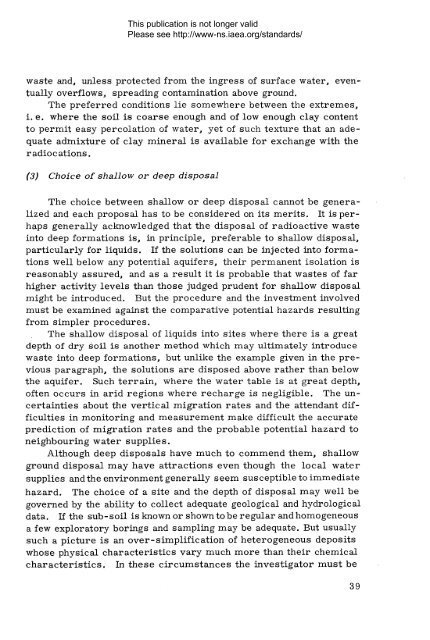Safety_Series_015_1965 - gnssn - International Atomic Energy ...
Safety_Series_015_1965 - gnssn - International Atomic Energy ...
Safety_Series_015_1965 - gnssn - International Atomic Energy ...
You also want an ePaper? Increase the reach of your titles
YUMPU automatically turns print PDFs into web optimized ePapers that Google loves.
This publication is not longer validPlease see http://www-ns.iaea.org/standards/waste and, unless protected from the ingress of surface water, eventuallyoverflows, spreading contamination above ground.The preferred conditions lie somewhere between the extremes,i. e. where the soil is coarse enough and of low enough clay contentto permit easy percolation of water, yet of such texture that an adequateadmixture of clay mineral is available for exchange with theradiocations.(3) Choice of shallow or deep disposalThe choice between shallow or deep disposal cannot be generalizedand each proposal has to be considered on its merits. It is perhapsgenerally acknowledged that the disposal of radioactive wasteinto deep formations is, in principle, preferable to shallow disposal,particularly for liquids. If the solutions can be injected into formationswell below any potential aquifers, their permanent isolation isreasonably assured, and as a result it is probable that wastes of farhigher activity levels than those judged prudent for shallow disposalmight be introduced. But the procedure and the investment involvedmust be examined against the comparative potential hazards resultingfrom simpler procedures.The shallow disposal of liquids into sites where there is a greatdepth of dry soil is another method which may ultimately introducewaste into deep formations, but unlike the example given in the previousparagraph, the solutions are disposed above rather than belowthe aquifer. Such terrain, where the water table is at great depth,often occurs in arid regions where recharge is negligible. The uncertaintiesabout the vertical migration rates and the attendant difficultiesin monitoring and measurement make difficult the accurateprediction of migration rates and the probable potential hazard toneighbouring water supplies.Although deep disposals have much to commend them, shallowground disposal may have attractions even though the local watersupplies and the environment generally seem susceptible to immediatehazard. The choice of a site and the depth of disposal may well begoverned by the ability to collect adequate geological and hydrologicaldata. If the sub-soil is known or shown to be regular and homogeneousa few exploratory borings and sampling may be adequate. But usuallysuch a picture is an over-simplification of heterogeneous depositswhose physical characteristics vary much more than their chemicalcharacteristics. In these circumstances the investigator must be39
















